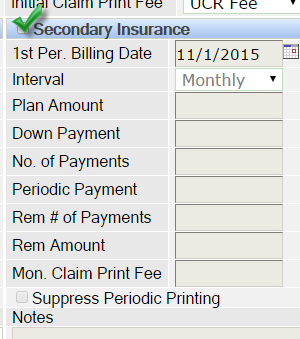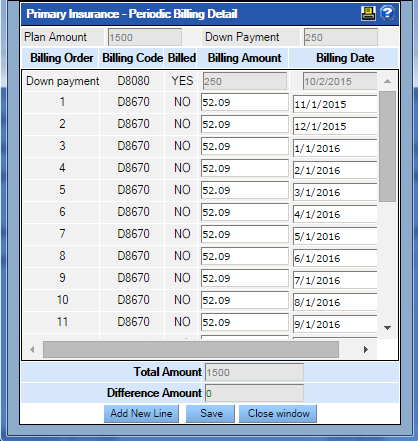Orthodontic Payment Plans
An orthodontic payment plan has many of the same features as a regular payment plan. There is a balance owed and a series of payments made periodically that will ultimately pay off that balance. QSIDental Web handles many of the calculations.
There are also differences. Some patients have dental insurance which will cover part of the orthodontic expense. These insurers will pay up to the annual or lifetime maximum, but frequently wish to do so in periodic payments. Therefore, the ortho payment plan allows both a patient and an insurance component. That insurance component can even be further divided between primary and secondary insurers.
Creating an ortho plan begins with the specific type of orthodontic procedure, the dates the treatment will begin, and the date it is estimated to conclude. From there, insurance and patient options are enabled and specific payment requirements set.
Create an Orthodontic Payment Plan
To create an ortho payment plan:
-
In the Ortho Payment Plan Agreement section of the
Patient Overview module, click the
Detail button.
 If the section is Ortho Payment Plan Agreement, the window for an orthodontic plan will open. If the section is Regular Payment Plan Agreement, the window for a regular plan will open.
If the section is Ortho Payment Plan Agreement, the window for an orthodontic plan will open. If the section is Regular Payment Plan Agreement, the window for a regular plan will open. -
Select the specific orthodontic procedure code from the
Code picklist.
 The fees and estimates for the insurance and patient portions will automatically populate based on the code selected, the insurance plan, and the appropriate fee schedule.
The fees and estimates for the insurance and patient portions will automatically populate based on the code selected, the insurance plan, and the appropriate fee schedule. -
Update the amounts if required by typing amounts in the
Fee, Est. Patient, and
Est. Insurance fields.
Today’s date will automatically be populated as the Treatment Start Date. If desired, select an alternate date by clicking the calendar icon.
-
Select the approximate Treatment End Date by clicking
the calendar icon.
Today’s date will automatically be populated as the Banding Date. If desired, select an alternate date by clicking the calendar icon.
-
If desired, select the check box beside Start Patient Payment
Plan to enable the fields for the patient side. If not enabled,
no patient portion will be included in the ortho payment plan.

-
Enter the information for the patient side of the orthodontic payment plan as
appropriate. If no patient side is needed, skip to step 9.
The Plan Amount will automatically populate based on the patient responsibility. Update the amount if required by typing a new amount in the Plan Amount field.
-
Enter the amount the patient will pay at the beginning of the contract, the
Down Payment.
The Amount Financed field will populate with the plan amount less the down payment.
-
Enter the APR (Annual Percentage Rate) if the practice
will charge any interest on the amount financed.
If a percentage is entered, the Finance Charge field will populate, and the amount in the Total of Payments field will increase to include those finance charges.

- In the Interval picklist, select how often the patient will make payments on the plan.
-
In the No. of Payments field, enter how many payments
the patient will make to pay the balance.
If the patient prefers to pay a specific amount, skip the field and the number of payments will be calculated by QSIDental Web.
-
In the Periodic Payment field, enter the amount the
patient will pay each period.
If the patient prefers to pay the balance over a specific time, skip the field and the amount will be calculated.


-
Select the desired disclosure from the Financial Disclosure to
Print picklist. Financial disclosures are written by the
practice and should be selected based on practice requirements. View the
disclosures by selecting Custom Letters from the
Reports menu.

-
If desired, click the checkbox beside Start Insurance Payment
Plan to enable the fields for the patient side. If not enabled,
no insurance portion will be included in the ortho payment plan.

- If no primary insurance side is required, skip to step 12.
-
Enter the information for the insurance side of the orthodontic plan for the
primary insurer as appropriate.
The billing code will populate by default based on the service code setup. Update the code if required by typing the new code in the Periodic Billing Code field.
-
Add any remarks as desired in the Remarks field. These
remarks appear in the remarks section of the claim form. By default the
description for the selected service code will appear. Select the malocclusion
class from the Insert Class picklist if desired.

-
Set the amount that should appear as the fee shown on the first claim to be
filed with the carrier. By default the practice’s UCR will be used, but the
contract price may be chosen from the picklist.
 The Plan Amount will automatically populate based on the insurance plan limits. Update the amount if required by typing a new amount in the Plan Amount field.
The Plan Amount will automatically populate based on the insurance plan limits. Update the amount if required by typing a new amount in the Plan Amount field. -
Enter the amount the carrier will pay at the beginning of the contract, the
Down Payment. This initial payment from the carrier
is typically a larger portion of the benefit.

-
Be sure the down payment is accurate for the carrier. If the amount received is
different from the anticipated amount, all further payments will be impacted and
the payment plan would likely need to be deleted and replaced.
The Amount Financed field will populate automatically with the plan amount less the down payment.
-
In the Interval picklist, select how often the carrier
will make payments on the plan.
 The No. of Payments field will populate based on the entered treatment end date and the selected interval. If this number is changed, the other fields will update accordingly. The Periodic Payment field will populate based on the plan amount and the number of payments. If this amount is changed, the other fields will update accordingly.
The No. of Payments field will populate based on the entered treatment end date and the selected interval. If this number is changed, the other fields will update accordingly. The Periodic Payment field will populate based on the plan amount and the number of payments. If this amount is changed, the other fields will update accordingly. Note: The Mon. Claim Print Fee field will calculate automatically and represents the fees billed to the carrier on a monthly basis even though the expected payment will be different. The fee is expressed as monthly even if the payment interval is set to another period.
Note: The Mon. Claim Print Fee field will calculate automatically and represents the fees billed to the carrier on a monthly basis even though the expected payment will be different. The fee is expressed as monthly even if the payment interval is set to another period. -
If desired, click the checkbox beside Suppress Periodic
Printing to disable automatic printing of the claims for the
ongoing payments. If left unchecked, claims are printed by default when the
periodic charges are generated through the utility.

-
Enter the information for the insurance side of the orthodontic plan for the
secondary insurer as appropriate. Secondary insurance must be associated with
the patient prior to adding the secondary insurance component. If there is no
secondary insurance, continue to step 12.

-
When everything has been validated and the plan is ready, click Save
Ortho Plan.
 Once saved, the plan information is locked (greyed out) and editing is limited. The contract, coupon, and billing details buttons will become active.
Once saved, the plan information is locked (greyed out) and editing is limited. The contract, coupon, and billing details buttons will become active.
- Print the payment contract for the patient by clicking Print Contract.
-
Print the installment coupons for the patient to use when sending the payment
by clicking Print Coupons.
The documents will open in a separate window for standard pdf printing.

Ortho Payment Plan Billing Details
With the payment contract in place, you can view the schedule of payments for either the patient or insurance side by clicking Billing Details on the Ortho Contract Details screen. The button on the patient side (left) launches the payment breakdown from the patient’s perspective, while the button on the insurance side (right) displays the insurance payment details.


Any payment amounts that have not yet been billed may still be adjusted (if allowed by security rights and practice policy) so long as the total amount is paid by the final payment.
Change a Payment in an Ortho Payment Plan
To change a payment:
- In the patient’s ortho plan detail screen, click Billing Details.
-
In the row for the specific payment, type the new payment amount in the
Billing Amount
field.
 QSIDental Web will not automatically adjust any other payments in the schedule. However, the difference created by the change in payment amount will appear at the bottom of the window.
QSIDental Web will not automatically adjust any other payments in the schedule. However, the difference created by the change in payment amount will appear at the bottom of the window. - Adjust another payment to account for the difference amount.For example, subtract from the last payment.Follow the practice’s policies for adjusting payments.
-
Click
Save.
Note: In some cases it may be easier to delete the plan and recreate it than to update a series of individual payments.
Generate Ortho Payment Plan Charges
To generate ortho payment plan charges:
-
Select Generate Ortho Payment Plan Charges from the
Utilities menu.
 Today’s date will populate in the Show Periodic Charges as of field. If desired, select an alternate date by clicking the calendar icon. If the date is changed, click Go to refresh the list.
Today’s date will populate in the Show Periodic Charges as of field. If desired, select an alternate date by clicking the calendar icon. If the date is changed, click Go to refresh the list.
-
In the
Generate Ortho Patient Payment Plan Charges
(top) section, select the check boxes beside the patients that need to have ortho payment plan charges added to the account. To select all payments, click the top check box in the blue header bar.

- When ready, click Post Patient Ortho Periodic Charges.
-
Click OK in the confirmation window.

-
In the
Generate Ortho Primary Insurance Payment Plan Charges
(middle) section, select the check boxes beside the patients that need to have ortho payment plan charges billed to the primary insurance carrier. To select all payments, click the top check box in the blue header bar.

- When ready, click Post Insurance Ortho Periodic Charges.
-
Click OK in the confirmation window.

-
Repeat for charges for secondary insurance carriers if required.
The periodic charge for the patient will be posted to the patient’s ledger and become part of any current balance. The periodic charge for the primary insurance carrier’s charge will be posted to the patient’s ledger and can be billed using the normal claims process.

